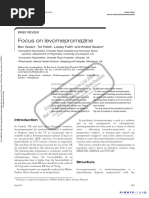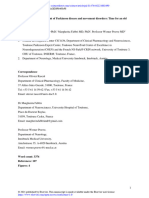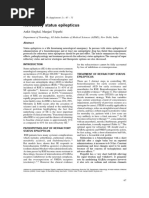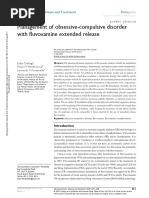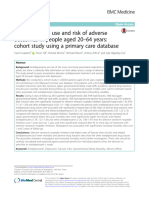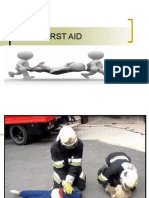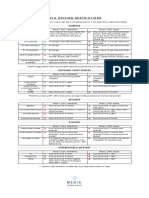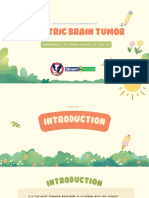Amisulprid 2
Amisulprid 2
Uploaded by
Robert MovileanuCopyright:
Available Formats
Amisulprid 2
Amisulprid 2
Uploaded by
Robert MovileanuCopyright
Available Formats
Share this document
Did you find this document useful?
Is this content inappropriate?
Copyright:
Available Formats
Amisulprid 2
Amisulprid 2
Uploaded by
Robert MovileanuCopyright:
Available Formats
CURRENT MEDICAL RESEARCH AND OPINION®
Vol. 18, Suppl. 3, 2002, s18–22 10.1185/030079902125001083
© 2002 LIBRAPHARM LIMITED
Amisulpride: Progress and
Outcomes
Y. Lecrubier
The French Institute of Health and Medical Research, Hôpital La
Salpêtrière, Pavillon Clérambault, Paris, France
Address for correspondence: Professor Y. Lecrubier, The French Institute of Health
and Medical Research, INSERM - Unité 302, Hôpital La Salpêtrière, Pavillon
Clérambault, 47, Boulevard de l’Hôpital, 75651 Paris Cedex, France
Curr Med Res Opin Downloaded from informahealthcare.com by Kainan University on 04/30/15
Keywords: Schizophrenia – Antipsychotic – Amisulpride – Haloperidol – Risperidone –
Positive symptoms – Negative symptoms – Quality of life
SUMMARY
Amisulpride is a unique atypical antipsychotic determined by PANSS negative subscale
that selectively blocks D2 and D3 receptors compared with risperidone; and similar levels
5
presynaptically in the frontal cortex, possibly of EPS .
For personal use only.
enhancing dopaminergic transmission, and Amisulpride uniquely benefits patients with
postsynaptically in the limbic areas, possibly negative symptoms and is the only
1–3
reducing it . Thus dopaminergic over-activity antipsychotic to demonstrate efficacy in
in the frontal cortex, and under-activity in the patients with predominantly negative
6–8
limbic areas, can be treated simultaneously, symptoms . Amisulpride maintains its
alleviating both positive and negative efficacy when used for medium/long-term
symptoms of schizophrenia, respectively. treatment as demonstrated in studies of up to
9,10
In acute schizophrenia, amisulpride is at 12 months . Amisulpride demonstrates
least as effective as haloperidol, with a greater greater improvement in controlling symptoms
number of patients responding to treatment as compared to haloperidol. In terms of the
determined by Clinical Global Impression (CGI) relevance of the effects, a superiority is
4
scores ( p = 0.014) . In addition, amisulpride observed for quality of life, social adaptation
is associated with a lower incidence of and functioning as measured by the Quality of
extrapyramidal symptoms (EPS) as determined Life Scale (QLS), Clinical Glocal Impression
by Simpson–Angus scores (SAS) when scale (CGI) and Functional Status
4 11
compared with haloperidol ( p = 0.0053) . Questionnaire (FSQ) scales . Amisulpride also
Amisulpride showed similar efficacy to has one of the lowest potentials of all the
12
risperidone as determined by the Brief antipsychotic agents for weight gain . The
Psychiatric Rating Scale (BPRS) and the clinical evidence for amisulpride supports its
Positive and Negative Symptom Score (PANSS) earlier pre-clinical potential, showing it to be
positive subscale; a trend towards greater an atypical antipsychotic agent with specific
improvement of negative symptoms as clinical advantages.
Introduction mission in the frontal cortex and reduces it in the
limbic areas1,3. Since dopaminergic under-activity in
What makes amisulpride unique as an atypical the frontal cortex is thought to be related to negative
antipsychotic agent is its high selectivity for symptoms, and over-activity in the limbic system is
presynaptic D2/D3 receptors in the frontal cortex, believed to be related to positive symptoms,
and for postsynaptic D2/D3 receptors in subcortical amisulpride should present with a broad spectrum
limbic areas. Thus, it facilitates dopaminergic trans- pharmacological profile. In addition, the interaction
s18 Paper 2289
with striatal D2 receptors is very low reducing the CGI %: very much / much improved
likelihood of extrapyramidal symptoms (EPS). 100%
p = 0.014
Unlike other atypical antipsychotics, amisulpride has
minimal affinity for 5HT2, muscarinic, α1 adrenergic 62
or histaminergic H1 receptors1,3. This is in favour of a
44
low incidence of other side-effects. 50
This paper reviews recent clinical evidence dem-
onstrating the effectiveness of amisulpride in treating
the symptomatology of schizophrenia. In partic-
0
ular, amisulpride is compared with the classical Amisulpride 800 mg Haloperidol 20 mg
(n = 94) (n = 94)
antipsychotic, haloperidol, and another atypical,
risperidone, in both short- and medium/long-term
studies. Figure 1. Responder rates of amisulpride versus
haloperidol. A multicentre, double-blind trial of schizo-
phrenia patients (n = 191) with acute exacerbations
randomised to amisulpride (n = 95) or haloperidol
Efficacy of Amisulpride in (n = 96) for 6 weeks. CGI, Clinical Global Impression.
Patients with Positive Reproduced with permission from Möller et al., 19974
Curr Med Res Opin Downloaded from informahealthcare.com by Kainan University on 04/30/15
Symptoms
risperidone in terms of the percentage of responders,
The first priority in acutely psychotic patients is to defined as patients who improved by 50% or more, on
reduce positive symptoms. Amisulpride is at least as both the PANSS ( p < 0.036) and BPRS ( p < 0.02)
effective as reference drugs, such as haloperidol (clas- scales. The criterion of 50% improvement was more
sical) and risperidone (atypical), in the treatment of rigorous and realistic than the commonly used 20%,
positive symptoms. which makes this result even more impressive.
There was also a significant difference in favour of
amisulpride in the percentage of those who were
Amisulpride versus Haloperidol
For personal use only.
‘very much’ or ‘much improved’ on the CGI Scale
Patients treated with amisulpride showed similar ( p < 0.042)13,14. This suggested that the overall ther-
improvements in symptomatology to patients treated apeutic ratio was good and clinically relevant.
with haloperidol, as assessed on the Brief Psychiatric
Rating Scale (BPRS)4. Treatment with amisulpride
Efficacy of Amisulpride in Patients with
resulted in a significantly greater number of respond-
Negative Symptoms
ers than haloperidol ( p = 0.014), as demonstrated on
the Clinical Global Impression (CGI) scale (Figure 1). Treatment with amisulpride is associated with
significant improvements in negative symptoms
compared with placebo or other antipsychotics4,6,8,9.
Amisulpride versus Risperidone
Amisulpride produced significant improvements in
Amisulpride has been shown to be at least as effective negative symptoms compared with placebo
as risperidone in short and longer term studies5,13. A ( p < 0.02) over a 6-week period, when assessed on
recent clinical study comparing amisulpride (initially the Scale for the Assessment of Negative Symptoms
600 mg/day, then adjusted) with risperidone (6 mg/ (SANS) 6. In another medium/long-term study,
day, then adjusted) was conducted (The Amisulpride amisulpride produced significant reductions on the
Risperidone Study – AMIRIS). A total of 310 full range of negative symptoms, as assessed using
patients were followed for six months with a possible SANS9 (Figure 3). The effect of amisulpride on nega-
extension to one year. Just over 75% of the tive symptoms is maintained in all domains, in this
amisulpride-treated patients were of the paranoid case improving affective flattening, alogia, avolition/
type, compared with 70% of the patients treated with apathy, anhedonia/asociality, and attention impair-
risperidone. After 6 months, amisulpride was shown ment.
to be at least as effective as risperidone as determined
by the total of the PANSS scores14. There were no
significant differences for the other scales and Long-term Efficacy of
subscales, indicating that amisulpride generally shows Amisulpride
at least the same efficacy as risperidone (Figure 2).
In terms of the relevance of the global therapeutic Amisulpride and haloperidol were compared in a
effect, after six months, there was a statistically sig- 12-month, open-label, randomised, multicentre
nificant advantage for amisulpride compared with trial10. The improvement in positive symptoms,
Amisulpride: Progress and Outcomes Lecrubier s19
M6 – D0
PANSS PANSS PANSS
total positive negative BPRS SANS
Efficacy measure score
-5
ns
-10
-15 ns
ns
-20 ns
-25
-30
-35 *p < 0.001
Amisulpride Risperidone
*p non-inferiority
Curr Med Res Opin Downloaded from informahealthcare.com by Kainan University on 04/30/15
Figure 2. Medium-term efficacy of amisulpride versus risperidone. A double-blind, randomised, parallel-group study
of 310 patients treated with amisulpride (n = 152; 600 mg/day then adjusted) and risperidone (n = 158; 6 mg/day
then adjusted). Efficacy measures included Positive and Negative Symptom Scale (PANSS), Brief Psychiatric Rating
Scale (BPRS), and the Scale for the Assessment of Negative Symptoms (SANS)14
Mean change of SANS subscores between D0 and Dend (ITT)
%
60 p < 0.0002
p < 0.0002 p < 0.02
50 p < 0.0007
For personal use only.
40 p < 0.005
30
20
10
0
Affective Alogia Avolition Anhedonia Attention
flattening apathy asociality impairment
Amisulpride 100 mg (n = 69) Placebo (n = 71)
Figure 3. Amisulpride efficacy after 6 months in patients with predominantly negative symptoms. A multicentre,
parallel-group, double-blind, placebo-controlled study of 141 patients were randomised to amisulpride (n = 69)
100 mg/day or placebo (n = 72) for 6 months. All patients met DSM-III, two of Andreason’s criteria for negative
components of schizophrenia, a score of ≥60 on SANS and £50 on SAPS. Data were analysed on intent-to-treat basis.
Reproduced with permission from Loo et al., 1997 9
assessed on BPRS score, was significantly greater in improvement of negative symptoms between
the amisulpride group than in the haloperidol group amisulpride and haloperidol was even greater than
( p = 0.047) throughout the course of the study (Fig- the difference in positive symptom scores, suggesting
ure 4a). Most of the improvement occurred within a qualitative difference with respect to the two com-
the first month, and efficacy was maintained for the pounds in terms of negative symptoms.
duration of the study. This superiority of amisulpride
over haloperidol may be associated with signifi-
cantly fewer withdrawals due to lack of efficacy Tolerability
( p = 0.009) (Figure 4b).
Amisulpride also showed a significantly greater Several studies have found that amisulpride and
improvement in the negative symptom score on risperidone are better tolerated than haloperidol with
the PANSS scale compared with haloperidol regard to extrapyramidal symptoms (EPS)4,10,11,15.
( p = 0.0001) (Figure 4c). The difference in the Weight gain was also shown to be significantly greater
s20 Amisulpride: Progress and Outcomes Lecrubier
BPRS total score per visit
60
55
BPRS total score
50
Haloperidol (n = 117)
5–20 mg
45
p = 0.047
40
Amisulpride (n = 366)
200–800 mg
35
D0 D30 D90 D180 D270 D360
(a) Time (days)
Curr Med Res Opin Downloaded from informahealthcare.com by Kainan University on 04/30/15
Drop-out rate due to lack of efficacy/lost to follow-up
p = 0.009
30
22
Percentage of patients
20
12
10
For personal use only.
0
Amisulpride 200–800 mg Haloperidol 5–20 mg
(b) (n = 327) (n = 93)
PANSS negative subscore per visit
25
PANSS negative subscore
Haloperidol (n = 117)
5–20 mg
20 p = 0.0001
Amisulpride (n = 366)
200–800 mg
15
D0 D30 D90 D180 D270 D360
(c) Time (days)
Figure 4. Long-term efficacy of amisulpride. A multicentre, parallel-group, randomised, open-label trial of patients
(n = 489) with chronic or subchronic schizophrenia were treated with amisulpride 200–800 mg/day (n=370) or
haloperidol 5–20 mg/day (n = 119) for 12 months. (a) Improvement of positive symptomatology on the Brief
Psychiatric Rating Scale (BPRS); (b) Drop-out rates; (c) Improvement of negative symptomatology on the PANSS
negative subscale. Reproduced with permission from Colonna et al., 200010.
Amisulpride: Progress and Outcomes Lecrubier s21
Mean change from baseline
p = 0.026*
1.4
1.5
kg 1.0
0.4
0.5
0
Amisulpride 800 mg (n = 114) Risperidone 8 mg (n = 110)
*p within the amisulpride group: NS; p within the risperidone group: 0.0004
Data confirmed in AMIRIS Study (0.6 vs 1.4; p < 0.03)
Curr Med Res Opin Downloaded from informahealthcare.com by Kainan University on 04/30/15
Figure 5. Effect of amisulpride versus risperidone on weight gain. A multi-centre, parallel-group, double-blind trial of 228
patients with acute exacerbations of schizophrenia. After a 3–6 day washout, patients were randomised to amisulpride 800 mg/
day (n = 115) or risperidone 8 mg/day (n = 113). Reproduced with permission from Peuskens et al., 19995
with risperidone than with amisulpride (1.4 vs. 3. Perrault GH, Depoortere R, Morel E, Sanger DJ, Scatton
B. Psychopharmacological profile of amisulpride: an
0.4 kg, p = 0.026)5 (Figure 5). This observation was antipsychotic drug with presynaptic D2/D3 dopamine
confirmed in the AMIRIS study at eight weeks (1.4 receptor antagonistic activity and limbic selectivity. J
Pharmacol Exp Ther 1997;280:73-82
vs. 0.6 kg, p < 0.03) 13. 4. Möller HJ, Boyer P, Fleurot O, Rein W. Improvement of
acute exacerbations of schizophrenia with amisulpride: a
For personal use only.
comparison with haloperidol. Psychopharmacology 1997;
132:396-401
Conclusions 5. Peuskens J, Bech P, Möller HJ, Bale R, Fleurot O, Rein W.
Amisulpride versus risperidone in the treatment of acute
As would be predicted from the pharmacological pro- exacerbations of schizophrenia. Psychiatry Res 1999;88:
107-17
file of a pure D2/D3 receptor blocker, amisulpride is 6. Boyer P, Lecrubier Y, Puech AJ, Dewailly J, Aubin F.
an atypical antipsychotic agent, effective on positive Treatment of negative symptoms in schizophrenia with
amisulpride. Br J Psychiatry 1995;166:68-72
and negative symptoms, which can bring about an
7. Rein W, Fleurot O, Turjanski S. Amisulpride improves
additional improvement in the social functioning and affective symptoms in acute schizophrenia. In: Abstracts
the quality of life of patients with schizophrenia. of the 11th Congress of the European College of
Neuropsychopharmacology, Paris, France, 31 October – 4
Several studies have demonstrated efficacy in both November 1998. European Neuropsychopharmacology
positive and negative symptoms, and superiority over 1998;8(Suppl 2):S231
other antipsychotic agents, such as the atypical 8. Danion JM, Rein W, Fleurot O and the amisulpride study
group. Improvement of schizophrenic patients with pri-
risperidone, in terms of social interactions and perfor- mary negative symptoms treated with amisulpride. Am J
mance, as well as in terms of relevance of the thera- Psychiatry 1999;156:610-16
peutic effect observed. In addition to low levels of 9. Loo H, Poirier-Littre M-F, Theron M, Rein A, Fleurot O.
Amisulpride versus placebo in the medium-term treatment
EPS tolerance, as with all atypicals, amisulpride also of the negative symptoms of schizophrenia. Br J Psychiatry
shows a low incidence of side-effects such as weight 1997;170:18-22
10. Colonna L, Saleem P et al. Long term safety and efficacy of
gain that may contribute to improved compliance and amisulpride in subchronic or chronic schizophrenia. Inter-
enhanced long-term efficacy. national Clinical Psychopharmacology 2000;15:13-22
11. Carrière P, Bonhomme D, Lemperière T. Amisulpride has
a superior benefit/risk profile to haloperidol in schizophre-
nia. Eur Psychiatry 2000;15:321-29
References 12. Taylor DM, McAskill R. Atypical antipsychotics and
weight gain - a systematic review. Acta Psychiatr Scand
1. Schoemaker H, Claustre Y, Fage D, Rouquier L, Chergui 2000;101:416-32
K, Curet O, Oblin A, Gonon F, Carter C, Benavides J, 13. AMIRIS, Sanofi-Synthelabo. Data on file.
Scatton B. Neurochemical characteristics of amisulpride, 14. Lecrubier Y, Benkert O, Kasper S, et al. Amisulpride vs
an atypical dopamine D2/D3 receptor antagonist with both risperidone in schizophrenia: comparing clinical and func-
presynaptic and limbic selectivity. J Pharmacol Exp Ther tional outcome in a 6 month study. Presented at the ACNP
1997;280:83-97 2000. Abstr. No 196
2. Sokoloff P, Giros B, Martres MP, Bouthenet ML, Schwartz 15. Csernansky JG, Mahmoud R, Brenner R, The Risperidone -
JC. Molecular cloning and characterization of a novel dopa- USA - 79 Study Group. A Comparison of risperidone and
mine receptor (D3) as a target for neuroleptics. Nature haloperidol for the prevention of relapse in patients with
1990;347:146-51 Schizophrenia. N Engl J Med 2002;346:16-22
s22 Amisulpride: Progress and Outcomes Lecrubier
You might also like
- Stahl RX Swtiching Guide PDFDocument148 pagesStahl RX Swtiching Guide PDFscribd4kmh100% (7)
- Second and Third Generation Antipsychotics: A Comprehensive HandbookFrom EverandSecond and Third Generation Antipsychotics: A Comprehensive HandbookRating: 5 out of 5 stars5/5 (1)
- George M Case Study - AbnormalPsychology - v5-ANONYMOUSDocument7 pagesGeorge M Case Study - AbnormalPsychology - v5-ANONYMOUSHeathNo ratings yet
- Update On The Management of Symptoms in Schizophrenia: Focus On AmisulprideDocument11 pagesUpdate On The Management of Symptoms in Schizophrenia: Focus On AmisulpridepaulNo ratings yet
- Amisulprid - Alegerea AADocument5 pagesAmisulprid - Alegerea AARobert MovileanuNo ratings yet
- Amisulprid in SK 2Document13 pagesAmisulprid in SK 2Robert MovileanuNo ratings yet
- Aripiprazol in DeliriumDocument6 pagesAripiprazol in DeliriumRobert MovileanuNo ratings yet
- Manejo F20Document3 pagesManejo F20JUDITHNo ratings yet
- N I "M T ?": Ewer Typical NtipsychoticsDocument15 pagesN I "M T ?": Ewer Typical NtipsychoticsDrima EdiNo ratings yet
- Paul. 2004. Olanzapine in The Management of Bipolar DisorderDocument18 pagesPaul. 2004. Olanzapine in The Management of Bipolar DisorderRuth RachmawatyNo ratings yet
- Amisulprid 3Document5 pagesAmisulprid 3Robert MovileanuNo ratings yet
- Amisulprid in DepresieDocument11 pagesAmisulprid in DepresieRobert MovileanuNo ratings yet
- Eficacia de La Amisulprida para Los Síntomas Depresivos en Personas Con Trastornos Mentales Revisión Sistemática y MetanálisisDocument11 pagesEficacia de La Amisulprida para Los Síntomas Depresivos en Personas Con Trastornos Mentales Revisión Sistemática y MetanálisisIVAN ALVAREZNo ratings yet
- Green Focus Levomepromazina 2004Document5 pagesGreen Focus Levomepromazina 2004Psiquiatria Clinica ProyectarteNo ratings yet
- AripripazoleDocument13 pagesAripripazoleOneng IfayaniNo ratings yet
- Revisão AtípicosDocument29 pagesRevisão AtípicosFernanda GuimarãesNo ratings yet
- BurkeDocument10 pagesBurkeMary FallNo ratings yet
- Receptors Involved in Mental Disorders and The UseDocument17 pagesReceptors Involved in Mental Disorders and The Usedabafe4365No ratings yet
- ParanoiaDocument1 pageParanoiaFedericoFornariNo ratings yet
- 1-s2.0-S1474442221002490-amDocument24 pages1-s2.0-S1474442221002490-amNhư Bùi Lê QuỳnhNo ratings yet
- Frankel Schwartz 2016 Brexpiprazole and Cariprazine Distinguishing Two New Atypical Antipsychotics From The OriginalDocument13 pagesFrankel Schwartz 2016 Brexpiprazole and Cariprazine Distinguishing Two New Atypical Antipsychotics From The OriginalEsraa SaeedNo ratings yet
- Aripiprazol in Delirium La Pacientii VarstniciDocument10 pagesAripiprazol in Delirium La Pacientii VarstniciRobert MovileanuNo ratings yet
- The Treatment of Adult Bipolar Disorder With AripiprazoleDocument26 pagesThe Treatment of Adult Bipolar Disorder With AripiprazoleRajinder Kumar BassanNo ratings yet
- Adhd Newer DevDocument11 pagesAdhd Newer Devapi-228136529No ratings yet
- Farmacos AnsioliticosDocument8 pagesFarmacos AnsioliticosRoberto francoNo ratings yet
- Aripiprazole - Mechanism of Action, Clinical Efficacy and Side EffectsDocument10 pagesAripiprazole - Mechanism of Action, Clinical Efficacy and Side EffectsRuben Del CidNo ratings yet
- Clozapina 4Document7 pagesClozapina 4Robert MovileanuNo ratings yet
- Aripiprazole: Formulary ReviewDocument10 pagesAripiprazole: Formulary ReviewmissayayayaNo ratings yet
- Benzodiazepini: Za I Protiv: Benzodiazepines: Pro and ContraDocument6 pagesBenzodiazepini: Za I Protiv: Benzodiazepines: Pro and ContraMartinaDošenNo ratings yet
- Therapeutic Use of Psychedelic Drugs in Depression DisordersDocument1 pageTherapeutic Use of Psychedelic Drugs in Depression Disorders2456160056No ratings yet
- Schizophrenia: From Dopamine To Glutamate and Back: M.L. Carlsson, A. Carlsson and M. NilssonDocument11 pagesSchizophrenia: From Dopamine To Glutamate and Back: M.L. Carlsson, A. Carlsson and M. Nilssonbasit khanNo ratings yet
- Daat 07 I 2 P 144Document3 pagesDaat 07 I 2 P 144amit2352842No ratings yet
- Aripiprazol Discinecias Por LdopaDocument4 pagesAripiprazol Discinecias Por LdopaHercaiNo ratings yet
- AntipsychoticsDocument27 pagesAntipsychoticsfdamissieNo ratings yet
- AripiprazoleDocument4 pagesAripiprazolecibad52358No ratings yet
- Amphetamine, past and present a pharmacological and clinical perspective. Journal of PsychopharmacologyDocument19 pagesAmphetamine, past and present a pharmacological and clinical perspective. Journal of PsychopharmacologyRossy TrianaNo ratings yet
- Cariprazina in SK 2Document22 pagesCariprazina in SK 2Robert MovileanuNo ratings yet
- Refractory Status Epilepticus Neurologi AsiaDocument5 pagesRefractory Status Epilepticus Neurologi AsiabennyariepradanaNo ratings yet
- Antipsychotic Medication Prescribing Trends in A Tertiary Care HospitalDocument4 pagesAntipsychotic Medication Prescribing Trends in A Tertiary Care HospitalSilfa NataliaNo ratings yet
- Drug Study TramadolDocument7 pagesDrug Study TramadolZyrilleNo ratings yet
- Management of Obsessive-Compulsive Disorder With FDocument8 pagesManagement of Obsessive-Compulsive Disorder With FDamianUrozGarelliNo ratings yet
- Yasui Furukori2016Document3 pagesYasui Furukori2016Ags MxNo ratings yet
- Evaluation of Anti Manic Activity oDocument6 pagesEvaluation of Anti Manic Activity oamagamaNo ratings yet
- Azapirones For The Treatment of AnxDocument12 pagesAzapirones For The Treatment of AnxĐủ PhạmNo ratings yet
- Dose Reduction of Risperidone and Olanzapine Can Improve Cognitive Function and Negative Symptoms in Stable Schizophrenic PatientsDocument9 pagesDose Reduction of Risperidone and Olanzapine Can Improve Cognitive Function and Negative Symptoms in Stable Schizophrenic PatientsEmerson Serafim G. MonteiroNo ratings yet
- Modafinil and Armodafinil in Schizophrenia: Chittaranjan Andrade, MDDocument3 pagesModafinil and Armodafinil in Schizophrenia: Chittaranjan Andrade, MDbenedicte lewinNo ratings yet
- 1.11 Anti-Seizure Epilepsy (Seizures) Drugs - Rani Qasem 2015-2016Document27 pages1.11 Anti-Seizure Epilepsy (Seizures) Drugs - Rani Qasem 2015-2016Faisal FahadNo ratings yet
- Pramipexole - Fase 2Document7 pagesPramipexole - Fase 2moreiradossantos.carolina88No ratings yet
- Chlorpromazine Drug StudyDocument10 pagesChlorpromazine Drug Studyshadow gonzalezNo ratings yet
- Iprp 176653 Anticholinergic Discontinuation and Cognitive Functions in P 10Document11 pagesIprp 176653 Anticholinergic Discontinuation and Cognitive Functions in P 10AriefchsNo ratings yet
- Antipsychotic Present and FutureDocument34 pagesAntipsychotic Present and FuturepabitraNo ratings yet
- Ans NursingDocument15 pagesAns Nursingwww.nikhilbabu123No ratings yet
- Oral Presentation IGSCPS 2019 - JULAEHADocument13 pagesOral Presentation IGSCPS 2019 - JULAEHAJulaiha QosimNo ratings yet
- The Successful ConcurrentDocument5 pagesThe Successful ConcurrentShevamykolayovychshevchenko MilaniztyonlymilanelloNo ratings yet
- Drug Studyyy 57-59Document3 pagesDrug Studyyy 57-59Real TetisoraNo ratings yet
- 482 - Aripiprazole-Induced Tardive Dyskinesia in 13 Years Old Girl Successfully Treated With Biperiden A Case Report.Document3 pages482 - Aripiprazole-Induced Tardive Dyskinesia in 13 Years Old Girl Successfully Treated With Biperiden A Case Report.DivyeshNo ratings yet
- 2021 - Discoveryresearch and Development History of The Dopamine D2 Receptor Partial Agonists, Aripiprazole and BrexpipraDocument10 pages2021 - Discoveryresearch and Development History of The Dopamine D2 Receptor Partial Agonists, Aripiprazole and BrexpipraowenNo ratings yet
- Kumar 2009Document7 pagesKumar 2009C ONo ratings yet
- Drug Study FormatDocument2 pagesDrug Study Formatelmer.platiljrNo ratings yet
- AMAZEO (Amisulpride)Document14 pagesAMAZEO (Amisulpride)Konark DinkarNo ratings yet
- Clozapina in TABDocument7 pagesClozapina in TABRobert MovileanuNo ratings yet
- Clozapina Si RisperidonaDocument17 pagesClozapina Si RisperidonaRobert MovileanuNo ratings yet
- Cariprazina in SK 2Document22 pagesCariprazina in SK 2Robert MovileanuNo ratings yet
- Clozapina La Pacientii Tineri Cu SKDocument6 pagesClozapina La Pacientii Tineri Cu SKRobert MovileanuNo ratings yet
- Clozapina La Pacientii VarstniciDocument10 pagesClozapina La Pacientii VarstniciRobert MovileanuNo ratings yet
- Clozapina 5Document54 pagesClozapina 5Robert MovileanuNo ratings yet
- Cariprazina 1Document33 pagesCariprazina 1Robert MovileanuNo ratings yet
- Clozapina 1Document26 pagesClozapina 1Robert MovileanuNo ratings yet
- Duloxetina - Reactii Adv CardiovasculareDocument6 pagesDuloxetina - Reactii Adv CardiovasculareRobert MovileanuNo ratings yet
- Aripiprazol LAI Vs Paliperidona LAI in SKDocument10 pagesAripiprazol LAI Vs Paliperidona LAI in SKRobert MovileanuNo ratings yet
- Cariprazina in Depresia BipolaraDocument17 pagesCariprazina in Depresia BipolaraRobert MovileanuNo ratings yet
- Aripiprazol LAI in SK 2Document15 pagesAripiprazol LAI in SK 2Robert MovileanuNo ratings yet
- Mirtazapina 1Document26 pagesMirtazapina 1Robert MovileanuNo ratings yet
- Amisulprid in Depresie 2Document9 pagesAmisulprid in Depresie 2Robert MovileanuNo ratings yet
- Cariprazina in Depresia Bipolara 2Document13 pagesCariprazina in Depresia Bipolara 2Robert MovileanuNo ratings yet
- Amisulprid 5Document11 pagesAmisulprid 5Robert MovileanuNo ratings yet
- Amisulprid in DepresieDocument11 pagesAmisulprid in DepresieRobert MovileanuNo ratings yet
- Desvenlafaxina 4Document13 pagesDesvenlafaxina 4Robert MovileanuNo ratings yet
- Doxepina 1Document58 pagesDoxepina 1Robert MovileanuNo ratings yet
- Clomipramina 3Document6 pagesClomipramina 3Robert MovileanuNo ratings yet
- Duloxetina 1Document11 pagesDuloxetina 1Robert MovileanuNo ratings yet
- Antidepresive - Depresie + AlcoolDocument174 pagesAntidepresive - Depresie + AlcoolRobert MovileanuNo ratings yet
- Desvenlafaxina 2Document9 pagesDesvenlafaxina 2Robert MovileanuNo ratings yet
- Bupropion 1Document22 pagesBupropion 1Robert MovileanuNo ratings yet
- Antidepresive - Reactii Adverse (20-64 Ani)Document24 pagesAntidepresive - Reactii Adverse (20-64 Ani)Robert MovileanuNo ratings yet
- Antidepresive + Insuf. Hep.Document13 pagesAntidepresive + Insuf. Hep.Robert MovileanuNo ratings yet
- TAB 2 (EMa)Document53 pagesTAB 2 (EMa)Robert MovileanuNo ratings yet
- TP Borderline - Tratam 1Document22 pagesTP Borderline - Tratam 1Robert MovileanuNo ratings yet
- GSAQDocument1 pageGSAQGiga HasabiNo ratings yet
- Movement DisordersDocument4 pagesMovement DisordersKeerthikanthGubbalaNo ratings yet
- Trastornos de Alimentacion CIE 11Document19 pagesTrastornos de Alimentacion CIE 11Elene MezaNo ratings yet
- Work Done by Giovanna GomboDocument39 pagesWork Done by Giovanna GomboKatherine JonesNo ratings yet
- Worksheets - Isbar 3 StrokeDocument3 pagesWorksheets - Isbar 3 Strokeapi-673621869No ratings yet
- CPR & First AidDocument125 pagesCPR & First AidEvaNatashaNo ratings yet
- Counselling PsychologyDocument3 pagesCounselling PsychologyIrfan YounasNo ratings yet
- Alcohol Withdrawal: Pathophysiology, Diagnosis and TreatmentDocument30 pagesAlcohol Withdrawal: Pathophysiology, Diagnosis and TreatmentNab ShaayaNo ratings yet
- GlaoucomaDocument5 pagesGlaoucomaChristyl AmadorNo ratings yet
- Wjarr 2022 1252Document9 pagesWjarr 2022 1252Eduardo Luis Flores QuispeNo ratings yet
- Abnormal Psychology Pb1 - s2Document14 pagesAbnormal Psychology Pb1 - s2Jobelle Cariño ResuelloNo ratings yet
- Hypertension ReportDocument4 pagesHypertension Report6y7n2j4d2qNo ratings yet
- Down & Turner Syndrome 2Document19 pagesDown & Turner Syndrome 2omcf17005No ratings yet
- Contoh Draft Rubdown Acara SimposiumDocument3 pagesContoh Draft Rubdown Acara SimposiumdryusiaspanNo ratings yet
- Understanding the Pathophysiology of Type 1 and Type 2 DiabetesDocument62 pagesUnderstanding the Pathophysiology of Type 1 and Type 2 DiabeteswandaloveuNo ratings yet
- DVLA Null NewDocument1 pageDVLA Null NewTaniaNo ratings yet
- Pediatric Brain TumorDocument49 pagesPediatric Brain TumorJessica Victoria SudanawidjajaNo ratings yet
- HypertensionDocument10 pagesHypertensionSalman MajidNo ratings yet
- Psychological Disorders: Unit 14Document69 pagesPsychological Disorders: Unit 14Eric E CastroNo ratings yet
- EEG Chapter 10 - Epileptiform Normal Variant (NIF)Document27 pagesEEG Chapter 10 - Epileptiform Normal Variant (NIF)Yossy CatarinaNo ratings yet
- transcript-binge-eating-disorder-focusDocument39 pagestranscript-binge-eating-disorder-focusifclarinNo ratings yet
- BPD, DiagnosisDocument5 pagesBPD, DiagnosisMArko100% (1)
- Immune Health Questionnaire by MetagenicsDocument5 pagesImmune Health Questionnaire by MetagenicsDra. Ianna CarmoNo ratings yet
- Essay 3 Final Revision 1Document5 pagesEssay 3 Final Revision 1api-611013571No ratings yet
- Jurnal Internasional Draft 3Document8 pagesJurnal Internasional Draft 3thenytirtaNo ratings yet
- Narcissistic Personality DisorderDocument8 pagesNarcissistic Personality DisorderDay EnNo ratings yet
- Classification of Mental DisordersDocument23 pagesClassification of Mental DisordersThomas OwondoNo ratings yet
- Vitamin B12 InfographicDocument2 pagesVitamin B12 InfographicIan WynneNo ratings yet
- LECTURIO REVIEWER Mitzi Rosselle AlfaroDocument5 pagesLECTURIO REVIEWER Mitzi Rosselle AlfaroAngela May Pustasa AllamNo ratings yet













